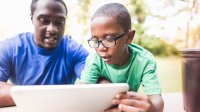How to Evaluate Online Science Resources for Early Learners
Guiding questions to help you discern which science resources are the best to share with parents—or use when you get back in the classroom.
Your content has been saved!
Go to My Saved Content.There is growing awareness that early science experiences are fundamental to children’s science learning, interests, and identities. Reflecting that fact, the Covid-19 school closings have resulted in a tidal wave of digital science resources aimed at preschool, kindergarten, and first-grade teachers.
As educators and researchers who support early science, my colleagues Claire Christensen and Regan Vidiksis and I wanted to help, but we were hesitant to add to the extensive list of online science videos, games, and activities teachers already had to sort through. Instead, we generated a set of questions teachers can use to evaluate the resources they find—on science websites, in apps, or on Youtube—and decide which ones to share with their young students and their families.
5 Questions to Consider When Vetting Science Resources
1. Does the resource introduce a big science idea that is accessible and appropriate for young children? Unlike facts—e.g., water freezes at 32 degrees Fahrenheit—big science ideas—like the idea that materials can be solid, liquid, or gas at different temperatures—enable children to apply their learning to new situations.
Examples of science ideas accessible to young children include:
Life science: All living things grow, develop, and have life cycles; they have needs, and they have parts that help them get their needs met; they depend on habitats, including other living things; and they exhibit diversity and variation.
Earth and space science: Materials like dirt and rocks can be observed and described; weather incorporates sunlight, temperature, wind, and precipitation, all of which can be measured and recorded; objects in the sky exhibit patterns that can be predicted; and people have impacts on other living things and the planet.
Physical science: Objects have characteristics and are made of materials that make them suited for specific purposes; objects roll, slide, or stay put depending on their properties and the properties of surfaces; sound has volume (loud or soft) and pitch (high or low); and light interacts differently with different materials.
2. Does the resource emphasize authentic and observable science phenomena (objects, materials, living things, and events) rather than abstract concepts? Instead of explaining big ideas to children, high-quality resources engage them in exploring relevant real-world phenomena that are presented as realistically as possible.
For example, an episode in the animated PBS series Wild Kratts introduces threatened animal species with their characteristics and behaviors presented accurately rather than anthropomorphically.
For a more interactive experience, the game Slidea-ma-zoo in the PBS Cat in the Hat Builds That app invites players to place butter or sand on different slides and observe the effects of friction in action as game characters slide down slowly or quickly.
3. Does the resource present science ideas and phenomena in a variety of ways? Young children learn best when ideas are presented using real or realistic artifacts, oral language, writing, visuals, actions, and animations when appropriate.
In the PBS game Dress That Rhino, for example, a narrator defines the term properties in child-friendly terms. Pictures, oral language, and written words are used to describe smooth, shaggy, rough, and other properties, and bright symbols and animations guide children to make predictions and test variables.
Similarly, the National Geographic Kids’ Amazing Animals video about the giant Pacific octopus uses live footage and narration, as well as maps, text boxes, and animation, to show and describe the animal’s physical characteristics, behaviors, needs, and habitat.
4. Does the resource get children actively engaged in the practices of science? A 21st-century vision of science education emphasizes the NGSS Science and Engineering Practices and the importance of doing, thinking, and communicating in science.
To let kids and their parents and guardians explore this point at home, teachers can suggest the Ramp and Roll activity in the PBS Kids Play and Learn Science app, which invites children to make and test ramps with marbles and other everyday objects. Other activities in the app have children generate questions, collect data, look for patterns, and talk and write about their discoveries and ideas.
In a Peep and the Big Wide World episode, characters model science practices as they explore how a flashlight works and observe and talk about how the sizes and shapes of their shadows change depending on how they move.
5. Does the resource make real-world science connections? Science resources are more effective when they make connections between big science ideas and related phenomena in the real world that are familiar to kids.
For example, the PBS Kids video Go Plant a Tree follows a group of children as they plant a tree and discuss why trees are important to the environment. The characters speak directly to the viewer about how to get involved in planting trees in their own communities.
An activity called Toy Take Apart engages children in using real tools to dissect their toys and discover how they were made. This one requires adult supervision.
Some high-quality resources will not address all five questions, and all resources are more effective when a child uses them in the company of a nurturing, invested adult who facilitates their use, acts as a co-explorer, and talks with the child about what they are doing, observing, and thinking.
For more information about choosing and using high-quality science resources with young children and their families check out Using Technology to Support Learning at Home: Simple Tips for Parents of Young Children and Preschool Science at Home: The Peep Family Science Apps.
